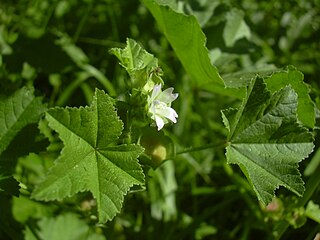
Sorghum or broomcorn is a genus of about 25 species of flowering plants in the grass family (Poaceae). Some of these species are grown as cereals for human consumption, in pastures for animals as fodder, and as bristles for brooms. Sorghum grain is a nutritious food rich in protein, dietary fiber, B vitamins, and minerals.

Quercus bicolor, the swamp white oak, is a North American species of medium-sized trees in the beech family. It is a common element of America's north central and northeastern mixed forests. It can survive in a variety of habitats. It forms hybrids with bur oak where they occur together in the wild.

Malvaceae, or the mallows, is a family of flowering plants estimated to contain 244 genera with 4225 known species. Well-known members of economic importance include okra, cotton, cacao, and durian. There are also some genera containing familiar ornamentals, such as Alcea (hollyhock), Malva (mallow), and Tilia. The genera with the largest numbers of species include Hibiscus, Pavonia, Sida, Ayenia, Dombeya, and Sterculia.

The tufted titmouse is a small songbird from North America, a species in the tit and chickadee family (Paridae). The black-crested titmouse, found from central and southern Texas southward, was included as a subspecies but now is considered a separate species, Baeolophus atricristatus.

Loxocemus bicolor, the sole member of the monotypic family Loxocemidae and commonly known as the Mexican python, Mexican burrowing python and Mexican burrowing snake, is a species of python-like snake found in Mexico and Central America. No subspecies are currently recognized. Analyses of DNA show that Loxocemus is most closely related to the true pythons and the sunbeam snakes.

The swamp wallaby is a small macropod marsupial of eastern Australia. This wallaby is also commonly known as the black wallaby, with other names including black-tailed wallaby, fern wallaby, black pademelon, stinker, and black stinker on account of its characteristic swampy odour.

The black-and-white mannikin also black-and-white munia or red-backed mannikin, is a species of estrildid finch, widely occurring throughout the African tropical rainforest. It has an estimated global extent of occurrence of 4,200,000 km2. It is found in moist savanna and subtropical or tropical moist lowland forest habitat. The status of the species is evaluated as least concern. They are seedeaters, but are known to feed on algae.

The dark-backed weaver, also known as the forest weaver, is a species of bird in the family Ploceidae. It is found in Angola, Burundi, Cameroon, Republic of the Congo, Democratic Republic of the Congo, Equatorial Guinea, Eswatini, Gabon, Kenya, Malawi, Mozambique, Nigeria, Rwanda, Somalia, South Africa, South Sudan, Tanzania, Uganda, Zambia, and Zimbabwe.

The black giant squirrel or Malayan giant squirrel is a large tree squirrel in the genus Ratufa native to the Indomalayan zootope. It is found in forests from northern Bangladesh, northeast India, eastern Nepal, Bhutan, southern China, Myanmar, Laos, Thailand, West Malaysia, Cambodia, Vietnam, and western Indonesia.

The bicolored roundleaf bat is a species of bat in the family Hipposideridae found in Indonesia, Malaysia, the Philippines, Thailand, and Timor-Leste. This bat inhabits caves, rock crevices and tunnels among lowland forests. They roost in large numbers and consume mostly small winged insects. Their navigation and hunting skills come from the use of echolocation. Its leafnose is used to release ultrasonic shouts to distinguish its surroundings. Echolocation is also used to distinguish other species based on their wingbeat and size. The habitat of this bat decides the color of its fur. Bleaching fumes of a cave environment will cause an orange colored fur. Those who inhabit a well-ventilated roost will be a light brown color.

Cerithiopsis is a genus of very small sea snails, marine gastropod mollusks or micromollusks in the family Cerithiopsidae.

Horologica anisocorda is a species of sea snail, a gastropod in the family Cerithiopsidae. It was described by Jay and Drivas, in 2002.
Horologica barrieria is a species of sea snail, a gastropod in the family Cerithiopsidae. It was described by Nützel, in 1998.
Belonimorphis cubensis is a species of sea snail, a gastropod in the family Cerithiopsidae. It was described by Rolán and Espinosa, in 1992.
Horologica konops is a species of sea snail, a gastropod in the family Cerithiopsidae. It was described by Jay and Drivas, in 2002.

Horologica lizardensis is a species of sea snail, a gastropod in the family Cerithiopsidae,.
Horologica semipicta is a species of minute sea snail, a marine gastropod mollusc in the family Cerithiopsidae.
Horologica turrigera is a species of minute sea snail, a marine gastropod mollusc in the family Cerithiopsidae. The species was described by Watson in 1886.

Theobroma bicolor, known commonly as the mocambo tree, jaguar tree, balamte, or pataxte, among various other common names, is a tree in the genus Theobroma, which also contains the better-known Theobroma cacao. It is found in Central and South America, including stretches of the Amazon rainforest in Brazil, Colombia, Ecuador, and Peru.
The black-and-white langur is a species of monkey in the family Cercopithecidae. It was formerly considered a subspecies of the Black-crested Sumatran langur, Presbytis melalophos but genetic analysis revealed that these are separate species.













